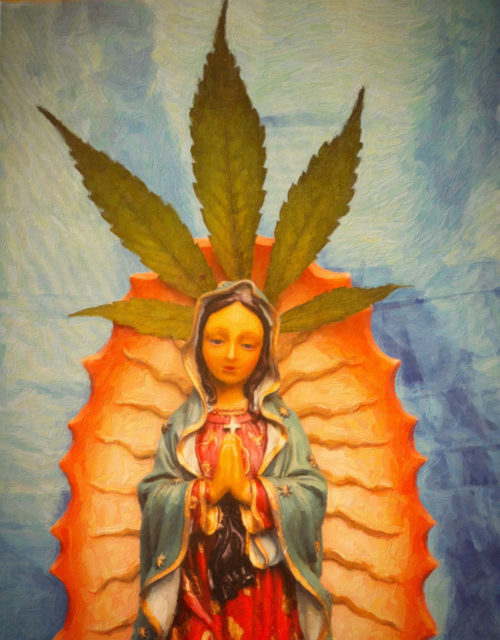Quick Guide to Cannabis as a Spiritual Ally
I’ve been prompted to write this “Quick Guide to Cannabis as a Spiritual Ally” because I’m seeing more and more people interested in making use of the sacred herb in that way, some of whom have been “cannabis friendly” for years and others of whom are what some in the field are now calling “cannabis naive.”
With the rapid spread of cannabis legalization and societal recognition, we’re starting to see more and more organized and semi- or loosely-organized opportunities for people to engage with the herb in ceremonial rituals and therapeutic environments. This bodes well.
However, in the meantime perhaps some folks less familiar with the plant could use a little guidance. What follows is a handy quick-reference guide. Please note that cannabis is the people’s plant and many of us are learning to use it effectively for spiritual awakening. I’m sure there are a lot of people who understand effective ways of working with cannabis for spiritual opening who could complement or even improve upon anything I can offer. So I welcome good ideas and may very well incorporate them into this Quick Guide as time goes by.
1. Respect: This plant has at least a multi-thousand year history of spiritual use on several continents. As with other entheogenic sacraments like peyote, psilocybin mushrooms, ayahuasca, and numerous others, people who have used cannabis spiritually throughout history have typically treated it with reverence. Rastafarians, for example, call it “the holy herb.” In India, many smokers pay homage to Shiva, the Lord of Bhang. In the Santo Daime syncretic ayahuasca-using religion, it’s known as Santa Maria, i.e. Saint Mary, and also Mother Mary, Mother Earth, and Pachamama. They say it comes from her sacred garden and will best reveal its gifts when honored and beseeched with humble respect.
In the view of many of us who know something about what this plant is truly capable of, it’s not a plaything. When properly understood and effectively worked with, cannabis is a strong and advanced spiritual medicine with numinous potential.
2. Intention follows naturally from respect. Cannabis is a non-specific amplifier, a generous and gracious energy-generating spiritual medicine. If your intention is to escape, it can amplify that intention. If your intention is to heal, to wake up spiritually, to open your heart, and to relax into peace, she can amplify and lubricate such intentions.
3. Discipline follows from intention. As I’ve written elsewhere and as a number of the contributors to the Cannabis and Spirituality book have pointed out, developing a beneficial spiritual relationship with cannabis isn’t a quick fix or a replacement for ongoing practices like meditation, yoga, and the like. It’s a path of gradually retraining ourselves to trust immediate felt perception and experience, or “Nowness” as it’s often called, rather than constantly falling back on the secondhand guesswork of our habitual patterns and beliefs about reality.
For the plant to do its spiritual healing and awakening work effectively, we need to learn how to pay attention, watch thoughts come and go without judgment, and acquire the “taste” of surrendering to non-thought presence, no matter how hard that seems to be or how long it takes. It’s called “unconditioned reality,” things as they are without the confused overlay of beliefs and concepts.
4. Set and Setting: The first three points above are part of what we call “set” in the term “set and setting.” Work with entheogens is generally much safer and more effective when set and setting are optimal. While cannabis is usually more forgiving than some of the so-called major entheogens, attention to setting can make a big difference. Creating or entering a quiet, safe, uplifting environment can dramatically improve the likelihood of a beneficial encounter with the holy herb.
5. Dosage is important, especially for “cannabis naive” people. The recommendation is to start with very small doses, especially with the high THC cannabis so common now and even more especially if the plant is taken orally, wherein the ceiling of effects is typically much higher (and of longer duration) than with inhalation.
Persistence comes into it here as well. If you’re not very familiar with cannabis, it’s not always obvious what’s going on and it may take repeated encounters to really begin to see how the plant does its energy-medicine healing work. Meeting the herb with no expectations about how this should go is likely to be the most successful attitude. Let the plant show you itself and invite you in with as little distraction as possible.
In some sense it’s not about being high but about being fully present, and as an amplifier, with that disclipined attention, cannabis can make you feel more real, more authentic. A light dose can be subtle and sweet. A strong dose can be transcendent (and really sweet.) A good long term plan is to gradually up the dosage as you learn to stay relaxed, present, and at least to some degree free of compulsive “head traffic.”
6. Overdosing and antidotes: There’s far too much on this subject to do it justice in a quick guide like this. The book goes into much more detail. In this context I’ll just say that you can definitely take more than you can effectively deal with, perhaps especially but by no means solely with orally ingested cannabis.
Note first that there’s no danger of a toxic overdose with cannabis. We’re talking about unwanted psychological and physiological experiences that are usually precipitated by feeling one’s cocoon, or ego, threatened by a strong dose. Cannabis can open us up but we have to let go into that experience. You can become frightened by that opening. You may not even realize that fear is the real driving force of your distress. You may just experience physical symptoms like tightness, dizziness, sudden exhaustion, panic attacks, or nausea. Or you may fall prey to terrifying thoughts that trick you into thinking irrevocable disaster is ruining you.
Although with orally ingested cannabis these effects can take much longer to subside, with inhaled cannabis you can often turn the experience around by working with the energy. The first technique is to keep breathing—to let the breath release and relax. Some loosening movement, even dancing, can help. If necessary, lie down, but keep working with the breath and letting go of fear-based, negative thoughts. It’s possible to transmute a disturbing experience into a beautiful one very quickly.
If further action is required, drinking citrus juices is said to help, coffee too. Rich, fatty food should put a noticeable damper on the high. One source claims that eating pine nuts or pistachios helps. Some say smoking a CBD-only strain of the herb calms. Others say a cold shower will bring you around quickly. At the extreme end, some pharmaceutical sedatives such as benzodiazepines may bring you back, perhaps especially with those more persistent effects provoked by eating or drinking too much of the plant.
But rushing to employ these antidotes may indicate you’ve taken your fearful narrative seriously. (“Help! Stop the train! I want to get off!) So again, the primary recommended approach to working with these situations is to get out of your head and free the movement of energy. That may mean allowing yourself to lose control for awhile.
7. Strains; Cannabis sativa and Cannabis indica are two different species. Most commercially produced cannabis is a hybrid of the two. It basically comes down to experimentation. Everyone’s physical and psychological make-up are different. Some prefer sativa-dominant strains for spiritual work for their potentially sharper, more energizing effects. Those folks tend to find indicas more soporific and less awakening. Others prefer the potentially more body-relaxing and less thought-stimulating effects of indica-dominant strains.
Cannabis is a complex plant and many chemicals other than the famed THC play a role. You’ll be hearing a lot about CBD (cannabidiol) in the months and years to come. CBD is the second most prevalent cannabinoid in the plant after THC. Researchers say the significant presence of CBD in a plant limits the high engendered by THC but also extends the duration of the high. CBD is described as having calming effects that some ‘explorers’ may find salutary in meditative work.
8. Source: This is getting into more refined territory. I’m hearing more and more often these days that people are finding greater benefit from cannabis they know has been organically grown with love and reverence—and perhaps prayed over. I know skilled, mature cannabis people who say they can tell from the first toke what the mindset and intention of the grower was.
9. Frequency of use: This is a tough one. I keep meeting intelligent, mentally healthy, actively engaged people who use cannabis daily. They say it puts them in the right zone—more balanced, more relaxed, more present. I wouldn’t argue with that. But there is a significant tolerance effect with heavy use. As discussed by several of the 18 contributors to Cannabis and Spirituality, less frequent use is usually necessary to experience the full opening, transcendent effects of cannabis. One of those contributors, Brazilian ayahuasca shaman Mariano da Silva, said that leaving 5 to 7 days between sessions makes a big difference. As he put it:
“It’s a transcendental effect that really opens your mind, enhances your perception, softens your heart more, calms you down, and facilitates a kind of interaction. I have a lot of respect for cannabis. But if I use it every day, I don’t feel this kind of effect from it anymore.”
Another important consideration on the frequency of use issue is dependence. Some call it addiction, although on a purely physiological level the plant is barely addictive. Heavy users who quit suddenly typically only experience “mild and transitory” withdrawal effects.
But psychological addiction/dependence can be powerful and harmful. Watch out for the seduction of the sweet offerings of the beautiful plant. It can lead you away from healthy, productive relationships with the “daylight world.”
10. Read other essays on this site, read posts on the Facebook group “Cannabis and Spirituality,” and especially read the book Cannabis and Spirituality: An Explorer’s Guide to an Ancient Plant Spirit Ally (Inner Traditions • Park Street Press, Jan. 2017). The whole purpose of the project is to help people of varying levels of experience with the sacred herb make use of it for spiritual benefit.
11. Even quicker: To boil all of this down to one over-simplified bit of guidance, “Sit down, shut up, and pay attention.” Expect nothing, allow all thoughts to rise and fall away without judgment, let the breath heal, and let the kindly plant do its freeing, reality-engendering work as unobstructed as possible by the noise we tend to compulsively generate in our heads.
As Julie Holland M.D. wrote in the Foreword to Cannabis and Spirituality, “Open your heart and your mind and take your time.”












Leave a Reply
Want to join the discussion?Feel free to contribute!